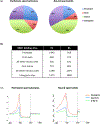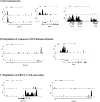Genome-wide chromatin occupancy of BRDT and gene expression analysis suggest transcriptional partners and specific epigenetic landscapes that regulate gene expression during spermatogenesis
- PMID: 33469999
- PMCID: PMC9342626
- DOI: 10.1002/mrd.23449
Genome-wide chromatin occupancy of BRDT and gene expression analysis suggest transcriptional partners and specific epigenetic landscapes that regulate gene expression during spermatogenesis
Abstract
BRDT, a member of the BET family of double bromodomain-containing proteins, is essential for spermatogenesis in the mouse and has been postulated to be a key regulator of transcription in meiotic and post-meiotic cells. To understand the function of BRDT in these processes, we first characterized the genome-wide distribution of the BRDT binding sites, in particular within gene units, by ChIP-Seq analysis of enriched fractions of pachytene spermatocytes and round spermatids. In both cell types, BRDT binding sites were mainly located in promoters, first exons, and introns of genes. BRDT binding sites in promoters overlapped with several histone modifications and histone variants associated with active transcription, and were enriched for consensus sequences for specific transcription factors, including MYB, RFX, ETS, and ELF1 in pachytene spermatocytes, and JunD, c-Jun, CRE, and RFX in round spermatids. Subsequent integration of the ChIP-seq data with available transcriptome data revealed that stage-specific gene expression programs are associated with BRDT binding to their gene promoters, with most of the BDRT-bound genes being upregulated. Gene Ontology analysis further identified unique sets of genes enriched in diverse biological processes essential for meiosis and spermiogenesis between the two cell types, suggesting distinct developmentally stage-specific functions for BRDT. Taken together, our data suggest that BRDT cooperates with different transcription factors at distinctive chromatin regions within gene units to regulate diverse downstream target genes that function in male meiosis and spermiogenesis.
Keywords: BRDT; male meiosis; spermiogenesis; transcription.
© 2021 Wiley Periodicals LLC.
Conflict of interest statement
Conflict of Interest Statement
The authors declare they have no competing interests.
Figures





Similar articles
-
BRDT is an essential epigenetic regulator for proper chromatin organization, silencing of sex chromosomes and crossover formation in male meiosis.PLoS Genet. 2018 Mar 7;14(3):e1007209. doi: 10.1371/journal.pgen.1007209. eCollection 2018 Mar. PLoS Genet. 2018. PMID: 29513658 Free PMC article.
-
The first bromodomain of Brdt, a testis-specific member of the BET sub-family of double-bromodomain-containing proteins, is essential for male germ cell differentiation.Development. 2007 Oct;134(19):3507-15. doi: 10.1242/dev.004481. Epub 2007 Aug 29. Development. 2007. PMID: 17728347
-
RFX2 is a potential transcriptional regulatory factor for histone H1t and other genes expressed during the meiotic phase of spermatogenesis.Biol Reprod. 2004 Nov;71(5):1551-9. doi: 10.1095/biolreprod.104.032268. Epub 2004 Jun 30. Biol Reprod. 2004. PMID: 15229132
-
The role of the double bromodomain-containing BET genes during mammalian spermatogenesis.Curr Top Dev Biol. 2013;102:293-326. doi: 10.1016/B978-0-12-416024-8.00011-8. Curr Top Dev Biol. 2013. PMID: 23287038 Free PMC article. Review.
-
MicroRNAs and DNA methylation as epigenetic regulators of mitosis, meiosis and spermiogenesis.Reproduction. 2015 Jul;150(1):R25-34. doi: 10.1530/REP-14-0643. Epub 2015 Apr 7. Reproduction. 2015. PMID: 25852155 Review.
Cited by
-
Expression profiles of meiotic genes in male vs. female gonads and gametes: Insights into fertility issues.Front Genet. 2023 Mar 14;14:1125097. doi: 10.3389/fgene.2023.1125097. eCollection 2023. Front Genet. 2023. PMID: 36999055 Free PMC article.
-
RBM24 regulates apoptosis rates by modulating global transcriptome profile in CAL27 cells.Sci Rep. 2025 Apr 9;15(1):12069. doi: 10.1038/s41598-025-96932-5. Sci Rep. 2025. PMID: 40200085 Free PMC article.
-
Epigenetic markers in the embryonal germ cell development and spermatogenesis.Basic Clin Androl. 2023 Feb 23;33(1):6. doi: 10.1186/s12610-022-00179-3. Basic Clin Androl. 2023. PMID: 36814207 Free PMC article. Review.
-
Cancer/Testis Antigens as Biomarker and Target for the Diagnosis, Prognosis, and Therapy of Lung Cancer.Front Oncol. 2022 Apr 27;12:864159. doi: 10.3389/fonc.2022.864159. eCollection 2022. Front Oncol. 2022. PMID: 35574342 Free PMC article. Review.
-
A-MYB and BRDT-dependent RNA Polymerase II pause release orchestrates transcriptional regulation in mammalian meiosis.Nat Commun. 2023 Mar 29;14(1):1753. doi: 10.1038/s41467-023-37408-w. Nat Commun. 2023. PMID: 36990976 Free PMC article.
References
-
- Al-Harthi L, & Roebuck KA (1998). Human immunodeficiency virus type-1 transcription: role of the 5’-untranslated leader region (review). Int J Mol Med, 1(5), 875–881. Retrieved from http://www.ncbi.nlm.nih.gov/pubmed/9852310 - PubMed
-
- Ayoubi TAY, & VanDeVen WJM (1996). Regulation of gene expression by alternative promoters. Faseb Journal, 10(4), 453–460. Retrieved from <Go to ISI>://WOS:A1996UE55700009 - PubMed
Publication types
MeSH terms
Substances
Grants and funding
LinkOut - more resources
Full Text Sources
Other Literature Sources
Molecular Biology Databases
Miscellaneous

